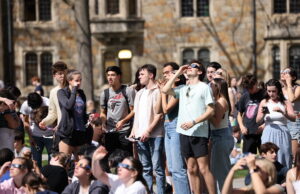Native American challenges continue today
To state that Native Americans’ experiences are commonly overlooked in our education system is not a shocking conclusion. However, many believe that Native American history is just that: history. In reality, much of the overlooked adversity that Native individuals dealt with in the past is still present in society.
The understanding that most students have of Indigenous history is somewhat vague. Many of us learn about American conquests and “Manifest Destiny” with a brief reference to the poor treatment of Native peoples. However, this explanation is grossly simplified. We learn to understand European victory, not Indigenous grief.
The terms “Battle of Fallen Timbers”, “Indian Removal Act of 1830” and “Trail of Tears” are tossed around in classrooms as vocabulary, but no deeper understanding or connection is ever made before classes rush towards the next topic. The simple truth is that brutality is often glossed over and genocide is frequently glorified. Students are shielded from these realities, and so too are we shielded from confronting our country’s dark foundation.
It is important to realize that the figures we hear about in textbooks are real individuals who lived real lives. The children they gave birth to continue to be impacted by the effects of their ancestors’ treatment. Rates of penury, suicide and violence are still heartbreakingly prominent within reservations, with Northwestern’s Institute for Policy Research stating that one out of every three Native Americans are currently living in poverty. Yet, these issues are ignored in most classrooms and newspaper headlines.
Inaccurate representation in both the media and education is not the only challenge that is affecting current Indigenous communities. Generational trauma has affected many Native Americans for hundreds of years. Evidence suggests that in reaction to the plight of land seizures, and the “boarding school generations,” many lost their sense of culture and identity, leading to physical and emotional wounds which have harmed entire bloodlines. According to the National Institute of Drug Abuse, “drug addiction among Natives is 300% higher than the national average.”
Another difficulty that Native peoples are suffering through is the continued removal of their land, much of this land being sacred spaces, for economic and industrial profit. Currently, the federal government has legal control of such Native lands, therefore acting as a “trustee” on behalf of its Indigenous occupants, and effectively restricting its peoples from the freedom to make decisions that could significantly assist them in another area of concern: poverty.
Due to the government possessing their property, Natives do not have the authority to sell, purchase, borrow or take advantage of the natural resources that their homes offer. Even if Natives were given a proper voice in the conversations that determine what is to happen with the land under their feet, another complication arises. The land in which Indigenous peoples live is often intertwined with their history and traditions that can not be easily pushed aside.
Disregarding damaging external forces, several internal issues are severely impacting Native communities. These include, but are not limited to violence against women and human trafficking. As reported by Native Hope, Indigenous women confront murder rates which are 10 times the national average, and approximately 80 percent have experienced assault. Much of this is due to the sparsity of law enforcement, making them easy subjects for aggression.
Despite the countless adversities that Native American people are forced to counter in modern-day society, there are still steps that can be taken to ensure a more progressive future. Many young Native peoples have become more involved in their culture through art, dance and storytelling. Another important step is educating non-Indigenous people on both the history and present-day realities of such groups.
Instead of our classrooms skimming over America’s neglect and abuse of its Native population, students must be educated on both the historical and current Native experience. Through acknowledgment and eventual action, society as a whole can hopefully look towards a nation that admits to the mistakes of the past and takes strides towards a world where Native Americans will not constantly face the genocide and confusion that has been following them for five centuries. As students, we demand better from our education system. Do not teach us to celebrate massacre and occupation. Teach us accountability. Teach us to coexist.



